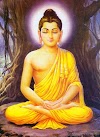1. The Lotus Blossom Stupa of the Buddha’s Birth (Wyl. sku bltams mchod rten)
The Lotus Blossom Stupa symbolizes the birth of Siddhartha, the man who would later be known as the Buddha. He was born in the Lumbini Garden at Kapilavastu in Nepal in the sixth century BCE. The steps of the stupa are round and decorated with lotus petals.
The Lotus Blossom Stupa symbolizes the birth of Siddhartha, the man who would later be known as the Buddha. He was born in the Lumbini Garden at Kapilavastu in Nepal in the sixth century BCE. The steps of the stupa are round and decorated with lotus petals.
2)The Enlightenment Stupa (Wyl. byang chub mchod rten)
After sitting in meditation for 49 days under a tree at Bodhgaya, Siddhartha attained enlightenment, and understood the true nature of all things. He realized that, like him, all beings without exception have the same potential for enlightenment, the ‘buddha nature’. The steps of the stupa are rectangular and undecorated.
After sitting in meditation for 49 days under a tree at Bodhgaya, Siddhartha attained enlightenment, and understood the true nature of all things. He realized that, like him, all beings without exception have the same potential for enlightenment, the ‘buddha nature’. The steps of the stupa are rectangular and undecorated.
3. The Stupa of Turning the Wheel of Dharma (Wyl. cho ‘khor mchod rten)
This stupa represents the point at which the Buddha began to ‘turn the wheel of the Dharma’, to teach the path to enlightenment to others. Also known as the Stupa of Many Doorways, the steps are adorned with doorways symbolising the opening of the doors of the Dharma.
This stupa represents the point at which the Buddha began to ‘turn the wheel of the Dharma’, to teach the path to enlightenment to others. Also known as the Stupa of Many Doorways, the steps are adorned with doorways symbolising the opening of the doors of the Dharma.
In the Deer Park at Sarnath, near Vanares, the Buddha met up with the five ascetics who earlier had been his meditation companions on the banks of the Nairanjara River. They became his first disciples and received his first teachings.
4. The Great Miracle Stupa (Wyl. cho ‘phrul gyi mchod rten)
This stupa commemorates the Buddha’s display of miracles at Shravasti, where he was challenged to demonstrate his realization. The Buddha responded by performing a different miracle every day for 15 days. Each of the four steps, in each of the four directions have central extensions.
This stupa commemorates the Buddha’s display of miracles at Shravasti, where he was challenged to demonstrate his realization. The Buddha responded by performing a different miracle every day for 15 days. Each of the four steps, in each of the four directions have central extensions.
5. The Stupa of the Descent from Tushita Heaven (Wyl. lha bab mchod rten)
The Buddha’s mother, Mayadevi, was reborn in a celestial realm called the Tushita Heaven. To repay her kindness, the Buddha spent three months there and taught her the path to enlightenment.
The Buddha’s mother, Mayadevi, was reborn in a celestial realm called the Tushita Heaven. To repay her kindness, the Buddha spent three months there and taught her the path to enlightenment.
This stupa represents the Buddha’s return from the celestial realms to Sankasya, Southern India in order to continue his teaching. Each side of the stupa has a stairway in the centre of the four steps.
6. The Stupa of Reconciliation (Wyl. dbyen bsdum mchod rten)
This stupa symbolizes the Buddha’s reuniting of his monastic followers after they had become divided by disagreement. The steps are octagonal with eight corners and eight sides.
This stupa symbolizes the Buddha’s reuniting of his monastic followers after they had become divided by disagreement. The steps are octagonal with eight corners and eight sides.
7. The All-Victorious Stupa (Wyl. rnam rgyal mchod rten)
This stupa symbolizes the Buddha’s agreement to extend his life by three months, after one of his followers had pleaded with him not to pass away. The steps of the stupa are round.
This stupa symbolizes the Buddha’s agreement to extend his life by three months, after one of his followers had pleaded with him not to pass away. The steps of the stupa are round.
8. The Parinirvana Stupa (Wyl. myang ‘das mchod rten)
This stupa marks the Buddha’s passing into nirvana, a state of true peace which is beyond death.
This stupa marks the Buddha’s passing into nirvana, a state of true peace which is beyond death.
With his final words, the Buddha urged his followers to be diligent in their efforts to attain enlightenment. Lying on his right side and in a state of profound meditation, he left the world and passed into nirvana. There are no steps in this stupa, the vase rests directly on the throne.







0 Comments